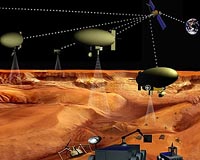 |
95 Air Base Wing Public Affairs Edwards AFB CA (SPX) Apr 23, 2010 Whether it's breaking through the sound barrier or flying different aircraft at the highest possible altitude, Edwards is no stranger to setting aviation records. Flight Test Nation delivered another first when the 418th Flight Test Squadron set a record for the heaviest single payload ever extracted out of a C-17 during flight April 14. A 77,000 pound jumbo drop test vehicle was extracted out of a C-17A T-1 at 25,000 feet over the U.S. Army Yuma Proving Ground in Arizona. The JDTV is used to test the parachutes for NASA's Ares I launch vehicle's solid rocket booster. NASA, in conjunction with Alliant Techsystems and the United Space Alliance, is providing a decelerator recovery system for the new five-motor segment solid rocket booster. This recoverable SRB is used in support of the Ares I space launch vehicle and is heavier than the current recoverable space shuttle SRB. The increase in weight requires a larger set of parachutes for deceleration and recovery. Testing must be accomplished in order to validate the design of a new drogue and new main parachutes for the Ares I launch vehicle. "The test is designed to collect data and to see how the parachutes react to different weights," said Ellis Hines, 418th FLTS, C-17 Ares project manager. "Once the entire testing is completed, eventually these parachutes will be attached to the Ares I boosters." Prior to this record 77,000-pound drop, the 418th FLTS has successfully completed 42-, 60-, and 70,000-pound JDTV Ares I airdrops. The next airdrop is scheduled for 2011 and will be with an 85,000-pound JDTV. The test program will culminate with a 90,000-pound airdrop scheduled for fall 2011. "We have to do this incrementally to see how the parachutes hold up," said Mr. Hines. "The ultimate goal is 90,000-pounds". The C-17 airdrop is part of the JDTV phase II test system which is comprised of a JDTV and a carriage extraction system. The CES is the carriage for the JDTV, which is used for transportation, aircraft loading, extraction and reorientation of the jumbo drop test vehicle prior to its release. Test pilots on the project have spent hours in the simulator and aircraft training for the drop tests, to include practicing contingencies and malfunctions and performing airdrops to prepare for the dynamic response of the aircraft during the extraction of the test vehicle. 418th FLTS engineers have partnered with Boeing to analyze the effects of these heavyweight drops on aircraft ramp structural members and collect data in real time during the drops. Additionally, mission systems engineers have worked hand in hand with Yuma Proving Ground personnel and NASA to develop rigging procedures for the airdrop platform and test vehicle.
Share This Article With Planet Earth
Related Links - Space Tourism, Space Transport and Space Exploration News
 NASA Selects Community College Scholars For Chance To Design Space Rovers
NASA Selects Community College Scholars For Chance To Design Space RoversWashington DC (SPX) Apr 22, 2010 Seventy-six students from community colleges in 28 states and the Commonwealth of Puerto Rico have been selected to travel to NASA's Johnson Space Center in Houston, May 20-22, for an out-of-this-world experience. They will participate in a three-day on-site event to develop robotic explorers that will rove the surfaces of other worlds. This event is the culmination of the National Communi ... read more |
|
| The content herein, unless otherwise known to be public domain, are Copyright 1995-2010 - SpaceDaily. AFP and UPI Wire Stories are copyright Agence France-Presse and United Press International. ESA Portal Reports are copyright European Space Agency. All NASA sourced material is public domain. Additional copyrights may apply in whole or part to other bona fide parties. Advertising does not imply endorsement,agreement or approval of any opinions, statements or information provided by SpaceDaily on any Web page published or hosted by SpaceDaily. Privacy Statement |